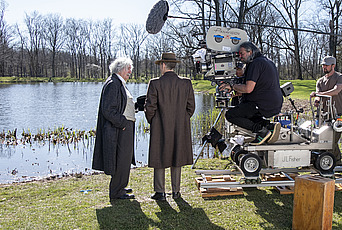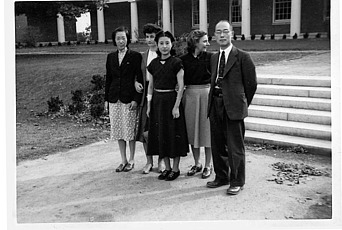Intimacy, Illumination, and Understanding…But First Drinks
In the Winter 1958 issue of Daedalus, J. Robert Oppenheimer, then-IAS Director (1947–66), published “The Growth of Science and the Structure of Culture,” an attempt to understand how scientific revolutions bear upon both cultural and disciplinary “conclusions about the nature of reality.” In the essay, Oppenheimer creates a lofty framework to understand the influence of science on culture, so readers may be surprised to learn that he concludes the essay quite simply:
"I think that the unity we can seek lies really in two things. One is that the knowledge which comes to us at such a terrifyingly, inhumanly rapid rate has some order in it. We are allowed to forget a great deal, as well as to learn. This order is never adequate. The mass of ununderstood things, which cannot be summarized, or wholly ordered, always grows greater; but a great deal does get understood.
The second is simply this: we can have each other to dinner. We ourselves, and with each other by our converse, can create not an architecture of global scope, but an immense, intricate network of intimacy, illumination, and understanding. Everything cannot be connected with everything in the world we live in. Everything can be connected with anything."
Intimacy, illumination, and understanding are, perhaps, a tall order for a dinner. However, shared meals have become pivotal architecture at the Institute for social and intellectual engagement. From our cherished teatime tradition to celebratory dinners, the Institute fosters its unique network of intimacy, illumination, and understanding by gathering its community around the table. The Shelby White and Leon Levy Archives Center is home to a range of documents which speak to dining at the IAS, from dinner menus to seating charts. Though such documentation hardly seems to offer much to scholarship as a singular item, cumulatively these records offer a fascinating glimpse into the history of shared meals at the Institute, a chance to wonder at possible conversations had across the table, and the opportunity to appreciate the intricate network we have built, and continue to build, by “having each other to dinner.”
This iteration of “From the Archives” originated with Landon Jones, long-time Friend of the Institute, who, having always found fruitful the relationship between food and thought, reached out to the Archives Center to share his research into the topic. Over the years, he has conducted interviews with IAS community members and amassed folders of historic documentation, showing how meals came to have a central significance from nearly the first academic term to present day.
In his study overlooking Marquand Park, Jones offers insights into the ways that scholars have often relied upon food as a metaphor to communicate complicated ideas in a universal way. We might consider the way that black holes “eat” the matter around them in astrophysics, for example, or the way that we ask for the “raw” data or “raw” numbers as an analogy in mathematics. These metaphors can offer significant insight into the way both scholars and the general public understand both the referent and the culture in which complicated ideas circulate.
As Oppenheimer states in his conclusion, such architectures are not often globally useful; while they can foster connections, these connections are limited in their capacity to illuminate everything. Oppenheimer, though, is clearly not only arguing for dinner” as metaphor. Anyone who has spent time at the Institute will have experienced first-hand the significant connections that a meal can make. The Archives Center’s materials offer us a glimpse at the possible connections made here, through table arrangements and seating charts, which, in turn, offer us a glimpse at the far vaster network of intimacy and illumination of which we are a part.
For instance, our records contain the preparations made by Frank Aydelotte, IAS Director (1939–47), for the dinner to celebrate Wolfgang Pauli’s Nobel Prize in Physics on December 10, 1945. The table arrangements preserved by the Institute’s Director’s Office even reveal the scholars seated among the table of honor. The tables provide a vision of the American pluralistic dream, the “melting pot (to use another food metaphor) at its best.
The Institute held a similar dinner during the tenure of Oppenheimer to honor C. N. Yang (School of Math/ Natural Sciences Faculty 1955–66) and T. D. Lee (Faculty 1960–62 in the same School) for their acceptance of the Nobel Prize for Physics in 1957. Perhaps unsurprisingly, the menus under Oppenheimer reflected a renewed sense of cosmopolitanism (featuring hot French bread and demi tasse), though the pre-dinner cocktails (a staple of mid-century American culture) remained.
Oppenheimer’s dinners serve as significant records to document the guests of the Institute that often went otherwise unrecorded. Records from 1961, for example, reveal that Oppenheimer held a dinner in honor of Sir Henry Willink but extended a last-minute invitation to another guest: Vladimir Nabokov. Nabokov’s name appears in Oppenheimer’s own hand on a list of invitees and sits next to the Director at the head of the table, only a few months before he would leave the United States for Switzerland for good. The handwritten note is the only record of Nabokov’s visit to the Institute that remains in the IAS archives. The addition provides insight into the intimacies of Institute life, and, yet it raises that perpetual question at the center of Oppenheimer’s conclusion: What do we make of a universe in which seemingly everything might be connected with anything? Might we strive forever without truly making sense of anything?
Oppenheimer’s final answer provides a glimpse of perhaps the most compelling option: we persist. If scholars continue to find ways to anthropomorphize black holes and archivists can still manage to keep up with the “terrifyingly, inhuman rapid rate” that we continue to produce and record new knowledge, there does seem to be hope. And though perhaps food metaphors are not always neatly all-encompassing, here’s one that is true: at the Institute, we are constantly nourishing one another. In this place where having each other to dinner means seating next to one another the physicist and the historian, the theologian and the anthropologist, the mathematician and the poet, we offer the opportunity for uninhibited association. And though we face large and complex challenges within a world where we cannot possibly understand everything, every time we come together over a meal and meet a colleague with a new perspective, we can look at such challenges with just a little more illumination and understanding.


